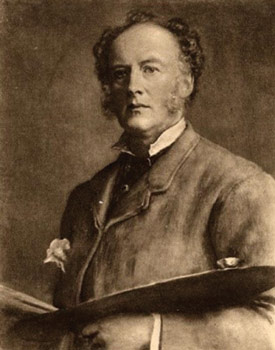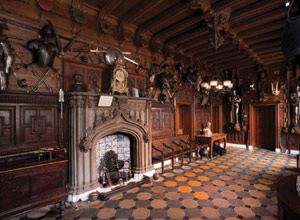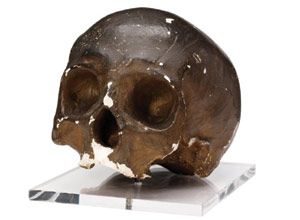|
THE BOXER, THE ARTIST AND THE AUTHOR
A painting by Millais in the Household Cavalry Museum
by Christopher Joll
formerly The Life Guards
|
In the reserve collection of the Household Cavalry Museum, held at Combermere Barracks, Windsor, is an 1847 signed and inscribed oil-on-board painting by the noted Victorian artist, Sir John Everett Millais (1829-1896). According to one of the labels on the reverse, the picture represents ‘The encounter between Shaw, the Lifeguardsman, and a French Cuirassier’ at the Battle of Waterloo: this was Corporal of Horse Jack Shaw (1789-1815) of the 2nd Life Guards. On the reverse are glued other bits of information relating to the picture, including a Royal Academy exhibition label and a handwritten note signed by Arthur Reid Lemprière:
This picture is an original by Sir J E Millais, done by him in 1847. I saw him do exactly every stroke in it. He gave it to me, writing my name himself in one corner. It was exhibited after his death at the Winter Exhibition of the Royal Academy of Arts in 1898. No 203 in the Catalogue.

A Huguenot on St Bartholomew’s Day
by Sir John Everett Millais. Private Collection
|
The Lempriere family were close friends of Millais and owned several of his works, six of which (including the Waterloo oil painting) were shown at the 1898 retrospective. The Lemprieres’ eldest son Arthur, later a Major General, was not - as might be expected given the subject of the painting - a Life Guard but a Royal Engineer whose sole claims to fame are that, in recognition of his survey work for the route of the Canadian Pacific Railway, he has a mountain and a railway junction in British Colombia named after him - and, as a young Sapper Lieutenant, he ‘sat’ for Millais. The resulting picture, painted in 1853, was ‘A Huguenot on St Bartholomew’s Day’, prints of which were a huge commercial success for the artist. It is unclear from the notes on the reverse of the Waterloo oil painting why Millais gave it to Arthur, but it is known that the artist was ‘keen’ on one of Lemprière’s sisters, so it may have been to curry favour with her sibling.
Following the Sapper General’s death, the painting passed to his brother who either gave it or sold it to the Rev Herbert James Shaw, a descendant of Millais’ central character, and it was finally given to the Household Cavalry Museum in 1980 by Miss Molly Shaw with notes prepared by Gordon E Robinson, Shaw’s great-great-great nephew.
Although Millais is currently out of fashion as an artist and Corporal of Horse Jack Shaw is but a footnote to the history of Waterloo, in their day both men enjoyed considerable fame. However, given their dates, they could never have met. So why in 1847 did Millais turn his artistic skills, which were usually dedicated to highly worked and romanticised scenes, to a relatively (by Millais’s standards) under-worked depiction of a minor skirmish in the most famous battle of the nineteenth-century? The answer may lie in the inter-connected stories of Millais, Shaw and the novelist, Sir Walter Scott (1771-1832).

Self-Portrait by Sir John Everett Millais, 1881
|
Sir John Everett Millais was a child prodigy who in 1840, at the age of eleven, was the youngest ever student of the Royal Academy Schools. Eight years later, a year after he had painted the Waterloo scene, he co-founded with his friends and fellow Royal Academy students, Holman Hunt and Dante Gabrielle Rossetti, the Pre-Raphaelite Brotherhood. This was a group dedicated to the rejection of what they believed were the corrupting influence on art of the Renaissance artist, Raphael; in his place, the Brotherhood promoted a return to the complex compositions of the Italian artists of the fourteenth-century.
Despite his lead role with the Pre-Raphaelites, Millais later rejected their precepts in favour of a broader style, which was to influence artists such as James McNeill Whistler and John Singer Sargent, although nothing in this body of work or that which pre-dates the formation of the Brotherhood resembles the Waterloo oil painting. Nonetheless, several of Millais’ early works include scenes of conflict and he was certainly familiar with Scott’s novels, not least because the Scotsman was Holman Hunt’s favourite author. Accordingly, from as early as 1841, Millais created paintings based on the Scottish novelist’s stories.
So much for Millais and his artistic connection with Scott; but what about Corporal of Horse Shaw?
‘Shaw did more to win the battle of Waterloo than did Wellington himself’. Thus wrote the historian and politician, Lord Macaulay. But until the institution of the Victoria Cross in 1857, most of the deeds of private soldiers and NCOs went unremarked by the public; an ‘other ranker’ with a profile that was unrelated to his military service was an even rarer creature. One such was Corporal Shaw who, in his lifetime, was famed as a prize fighter and artist’s model, as well as being recognised by Lord Macaulay as one of the heroes of the Battle of Waterloo. Were that not enough, he would later be immortalised by Charles Dickens in Bleak House when Inspector Bucket says: ‘… old Shaw, the Life Guardsman, why, he’s the model of the British Army itself. Ladies and gentlemen, I’d give a fifty pun’ note to be such a figure of a man.’
A prosperous Nottinghamshire farmer’s son, Shaw was a sickly child whose life was feared for by the local doctor, who prescribed ‘a liberal supply of new milk’ to save his life. His father assigned young Jack a cow for his exclusive use and the weakling child grew into a strapping adolescent weighing fifteen stone and standing just over six feet.
Apprenticed to a wheelwright at the age of thirteen, Shaw lost his place for fighting with his fellow apprentices and returned home in disgrace. He then turned his pugilistic hands to estate carpentry at Woolaton Hall, where he might have remained for the rest of his life had he not gone to the Nottingham Goose Fair. There, at the urging of his friends, he climbed into the ring for a prize fight with a local man much older and three stone heavier than himself. After several rounds, Shaw was starting to flag when a voice from the crowd yelled: ‘Youngster, do not give in, fight slow and careful, and you are sure to lick him as my name is Jem Belcher’. This encouragement from the Champion of All England must have inspired the young carpenter, for he went on to win the fight.
Nothing further is known about Shaw’s nascent boxing career until, two months short of his eighteenth birthday, he enlisted in the 2nd Life Guards. Soon after joining the Regiment, then stationed at Regent’s Park Barracks, there was an incident which marked him out as a natural boxer and launched his career in the ring: three yobs in Portman Square were shouting insults at passing soldiers and mocking their red tunics. Unfortunately for them, Shaw was one of the soldiers and, in short order, he knocked out all of them. This feat soon came to the ears of the officers of the 2nd Life Guards, some of whom were sporting Corinthians and keen supporters of the ‘noble art’. In no time at all, the necessary financial arrangements were made for Shaw to train at London’s leading boxing hall, Fives Court in Little St Martin Street. His success there prompted his commanding officer, Lieutenant Colonel (later General Sir) Robert Barton, a well-heeled sponsor of boxers, to send him to Jackson’s Rooms in Bond Street.
During his time at Jackson’s, Shaw’s handsome face and rippling physique also came to the attention of London’s artistic elite and, when not boxing or carrying out his (light) duties in the 2nd Life Guards, he developed a profitable side-line as an artist’s model, posing for Sir Edwin Landseer, Benjamin Haydon (in whose studio he met Sir Walter Scott), John Higton and William Etty, a noted painter of male nudes.
Back in the boxing ring, in 1812 Shaw was in contention for the Championship of All England. Unfortunately, Napoleon intervened and Shaw, recently promoted to Corporal of Horse, was sent with his Squadron (as part of the composite Household Brigade) to the Peninsula in October of that year. The following year the British Army crossed the Pyrenees and Napoleon abdicated, but Shaw did not return with his comrades to England. Instead, he accompanied Major General the Hon Sir William Ponsonby to Paris, where the General was tasked by Wellington with making the preparations for the Congress of Vienna and Shaw had the opportunity to fence with some French Cuirassiers; it was an experience that was to stand him in good stead two years later.
Early in 1815 Shaw returned to England, re-joined his Regiment and resumed his boxing career. On 18th April 1815, in front of a large crowd on Hounslow Heath, he faced Edward ‘Ned’ Painter. Over the next twenty-eight minutes Painter was knocked down ten times by Shaw; on the back of this success, Shaw proposed to challenge Tom Cribb for the All England Championship but, once again, Napoleon intervened.
With the ex-French Emperor on the loose from his exile on Elba, on 1st May 1815 the 2nd Life Guards sailed for Ostend and the Waterloo Campaign. Following the inconclusive clash at Quatre Bras, on 17th June at Genappe the 1st and 2nd Life Guards charged the advancing French to help cover the Allies’ fighting withdrawal to Waterloo. It was an action that earned the praise of the Earl of Uxbridge, the Allied cavalry commander, and a chest wound for Shaw. However, the wound was not nearly serious enough to keep the challenger for the All England crown from battle the next day so, after it had been dressed, Shaw returned to front-line duty with his Regiment.
What followed on 18th June 1815 is the stuff of both myths and legends, including the stories that Shaw and some of his colleagues had started the day by making very free with a rum ration, which they had been sent to collect, and that later in the morning the same group had been happily looting a dairy when they were rudely interrupted by the opening salvo of the battle. True or false, by the time the French attack started, Shaw was in the saddle with his sword drawn ready when the order came from Lord Uxbridge for both of the British Brigades of Heavy Cavalry - the Union and the Household - to disrupt the attack by D’Erlon’s Corps on the centre of the Allied line at La Haye Sainte farm. For the 2nd Life Guards this involved a charge at the French 1st Regiment of Cuirassiers, accoutred in steel breast-and-back plates (a fashion later adopted by the 1st and 2nd Life Guards). Based on his experiences in Paris, Shaw had already advised his Troop to aim their sword cuts at the base of a Cuirassier’s head, a spot which was unprotected by either cuirass or helmet.
The 2nd Life Guards duly smashed into the Cuirassiers, the effect being like ‘an irresistible force meeting an immovable object’. Some of the Cuirassiers fled whilst others stood their ground. One such was a Frenchman who openly challenged Shaw to single combat, the opening round of which was the subject of Millais’ painting. It was not a wise move on the part of the Cuirassier for, as he lunged, Shaw parried the Frenchman’s blade and then brought his own sword down on the man’s helmet, cleaving his head in half such that his ‘face fell off like a bit of an apple’. Eight more Cuirassiers now challenged Shaw and each in turn was despatched by a simple if unorthodox technique of swordsmanship: Shaw punched each in the face with the hilt of his sword and then sliced through their exposed necks as they turned their backs. The last man called out in English with an Irish accent ‘Damn you, I will stop your crowing’. He, too, fell like the rest.
Fired by their success in disrupting D’Erlon’s attack and routing the French cavalry, but against orders, both Brigades of Heavy Cavalry continued their charge into the French Grand Battery and on into the artillery waggon train behind it. That it was a terrible mistake became clear when the intermingled and thoroughly exhausted British heavy cavalry were counter-charged by two thousand five hundred fresh French cavalry consisting of Lancers and more Cuirassiers. Shaw found himself cut off from his Troop but continued with his slaughter of the French until his sword blade snapped. Undaunted, he then used the sword hilt as a club and, when that was dashed from his hand, ripped off his helmet and swung that as a weapon. In the end, with more than twenty sword wounds, Shaw was finally felled from his saddle by a wounded French drummer-boy’s pistol shot.
Mortally wounded, Shaw was dragged towards the French rear where he was dumped onto a dung heap. Here, he was joined by another wounded Life Guard. On seeing this man Shaw looked up and said: ‘Ah, my dear fellow, I’m done for’. When he was found the next morning by British troops, Shaw was indeed dead.
But that was not by any means the end of Corporal of Horse Jack Shaw. Initially, his body was buried in a marked grave (an unusual event in itself) at La Haye Sainte on the day after the battle but, several years later, it was disinterred for reburial in England. At this point, Sir Walter Scott re-enters the story. Shaw mythology asserts that his reburial was done at the urging of Scott, who had been obsessed with Shaw since he’d met him in Haydon’s studio. The mythology further asserts that Scott acquired Shaw’s skull and kept it in his library at Abbotsford where it ‘remains to the present day’.
History does not relate what happened to the rest of Shaw’s bones. Meanwhile, two plaster casts were made of the skull, one of which is now in the Household Cavalry Museum and the other was believed to be in the collection of the Royal United Services Institution’s, along with the skeleton of Napoleon’s horse, Marengo.
 Abbotsford - Shaw’s skull is on the right hand
end of the fire surround
|

Plaster cast of Shaw’s skull in the
Household Cavalry Museum |
It has recently emerged, however, that the skull owned by Scott and still on display in his Lowlands house, Abbotsford, is one of the plaster casts and that Shaw’s actual skull was the one held by the RUSI, although how the museum acquired it remains a mystery. In 1898, the then curator of the RUSI museum seems to have been queasy at exhibiting the human remains of a British soldier and he arranged with the incumbent of Shaw’s home church at Cossall in Lincolnshire to give the remains a decent burial ‘close to the pillar near the font’ and ‘adjacent to the Memorial to him’. This was done quietly on 21st June 1898.
Meanwhile, Scott’s obsession with Shaw and Millais’ admiration for Scott, may explain why the artist created the 1847 painting now in the collection of the Household Cavalry Museum. Indeed, it is possible that the study is actually a cartoon for a painting to hang at Abbotsford next to Shaw’s skull, which Millais never got around to executing. It is also possible that Millais, mindful always of symmetry, gave the oil on board to Arthur Lemprière because he was a serving soldier, as was Shaw when he posed for Haydon and other artists. Whether or not any of that was the case, the painting will soon be hung alongside the Household Cavalry Museum’s cast of Shaw’s skull on display at Horse Guards.
Christopher Joll is an author of military historical fact and fiction who also writes, directs and produces ‘military theatrical’ events for Armed Services charities. Recently appointed Regimental Historian of the Household Cavalry, Joll wrote the text of Uniquely British: A Year in the Life of the Household Cavalry, published in 2012.
This article is adapted from a profile of Corporal of Horse Jack Shaw to be published in Britannia’s Guards: The Heroes & Villains of the Household Division by Christopher Joll & Anthony Weldon. The author is grateful to the Trustees of the Household Cavalry Museum for permission to use material from the Museum archives.
|
|



 Abbotsford - Shaw’s skull is on the right hand
Abbotsford - Shaw’s skull is on the right hand 